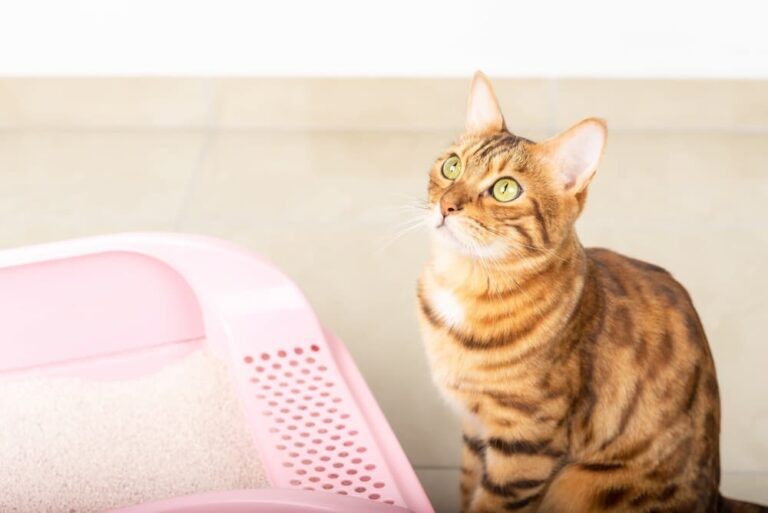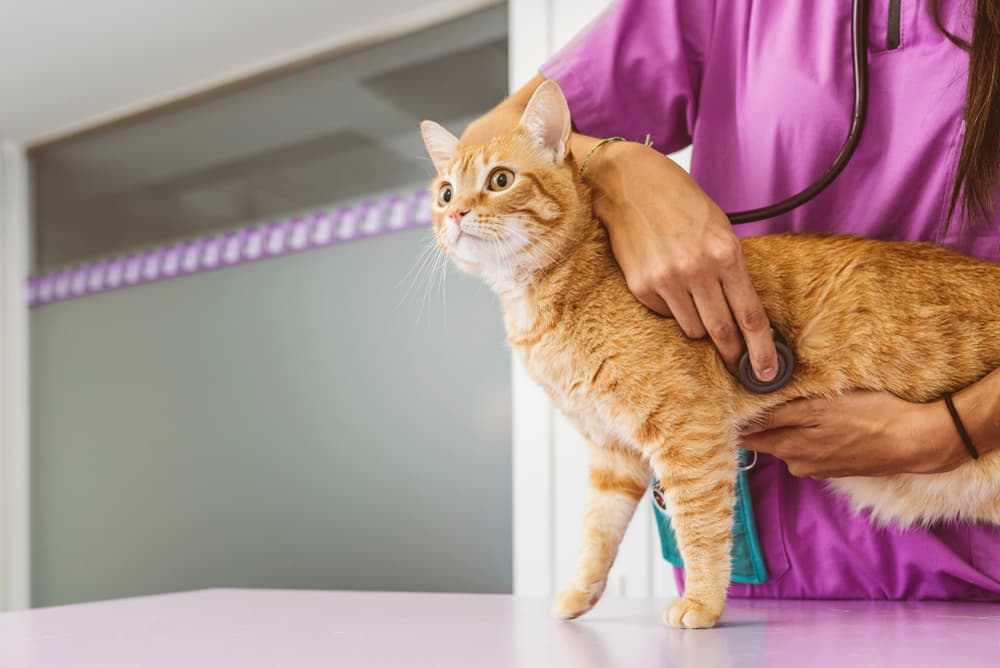Green Cat Poop: Causes and What It Means

It may be gross to think about, but your cat’s poop can provide an important glimpse into their overall health and well-being. Cats hide their illnesses and discomfort well, so stool changes may be the first noticeable sign that something is wrong. Often, stool changes are due to something minor, but other times they can indicate a serious health issue. Any time your cat’s poop is an abnormal color or consistency, it should be brought to the attention of a veterinarian.
In this article, we’ll answer the question, “Why is my cat’s poop green?” We’ll also share steps pet parents can take to determine the cause of green cat poop and help their feline friend feel better.
Green Cat Poop: Color, Consistency and Other Characteristics
Normal cat poop is light brown, soft, and well-formed. If you notice your cat is pooping green, that’s a sign something is amiss. Pet parents may notice different shades of green cat poop, which can range from light to dark green. Various consistencies including hard, soft, runny, or slimy cat poop may also be seen. Green cat poop can be well-formed or consistent with diarrhea and may contain mucus.
Pet parents should note specific characteristics of their cats’ poop so they are able to accurately describe them to the veterinarian. If you can, snap a picture or bring a sample of the poop with you to show your veterinarian because these can support an accurate diagnosis.
Why Is My Cat’s Poop Green?

Green poop in cats has many causes, ranging from underlying diseases to toxin ingestion to parasites and more. We will discuss some of the most common causes and why this alarming color change occurs.
Underlying Disease
Gallbladder and liver disease can result in green discoloration of a cat’s poop. The liver produces bile, which is a thin yellow-green liquid that is stored in the gallbladder. After a meal, the gallbladder releases bile into the intestines to aid in digestion. If there is a problem with bile production or storage, too much bile can be released. This typically results in loose stools that are green. Other symptoms that may indicate a problem with the liver or gallbladder include lethargy, jaundice (yellow discoloration of the skin and eyes), decreased appetite, vomiting, weight loss, and increased thirst and urination.
Toxin Ingestion
Some rodenticides contain a blue-green pigment. If a cat accidentally ingests one, their poop may turn green due to the dye in these products. Accidental ingestion of rodenticide is a medical emergency and should be treated by a veterinarian immediately. Cats who have ingested rodenticide will also have severe symptoms that may include abnormal bleeding, seizures, and labored breathing, among others.
Intestinal Parasites
Green and smelly cat poop can be a sign of intestinal parasites. Cats can become infected with several types of parasites, such as roundworms, hookworms, whipworms, and giardia. They cause inflammation within the intestines and interfere with the normal transit time of stool. When stool moves through the intestines quicker than it should, it can be green and runny.
Intestinal Inflammation
Cats who have inflammatory bowel disease, intestinal cancer, or a bacterial infection have higher levels of inflammation within their intestines. This can result in stool moving too quickly through the intestines, resulting in green discoloration. There may also be streaks of mucus present in the cat’s poop. Other symptoms cats may experience include weight loss, decreased appetite, and vomiting.
Dietary Indiscretion
If a cat eats something unusual, they may develop green poop as a result. There could be complete discoloration of the poop or specks of green throughout brown stool. For example, when cats ingest a lot of grass, their poop is likely to turn green. Similarly, this may occur with any foods containing a large amount of green pigment.
Diet Change
Abruptly changing a cat’s diet can result in food intolerance and green discoloration of the cat’s poop. Typically, once the cat adjusts to the new diet, the stool returns to normal. Some diets contain green dye as an additive, which can also have the same effect.
What To Do If Your Cat Has Green Poop

If you notice discolored poop inside your cat’s litter box, it’s important to know what steps to take. Sometimes it is OK to take a wait-and-see approach while other times it is important to get to the veterinarian as soon as possible. Let’s discuss the most appropriate actions for each situation. Of course, if you are ever in doubt about your cat’s well-being, seeing a veterinarian promptly is always the best option.
Let’s start with dietary indiscretion. If you know your cat has ingested some grass and you are seeing a few grass strands in your cat’s poop but your cat is acting perfectly fine otherwise, it will probably resolve itself once all of the grass has passed. However, if during this time your cat begins vomiting or stops eating, they should be brought to the veterinarian for evaluation.
Likewise, if you think the green cat poop is related to a recent diet change, try a bland diet for a couple days consisting of boiled chicken and cooked white rice and see if the stool returns to normal. Your veterinarian can also recommend a prescription diet that is easy on the intestines. If a bland diet does not resolve the issue, it’s time to see a veterinarian.
If you notice that your cat’s poop has changed in color or consistency without an identifiable cause or that your cat is just not acting like themselves, bring them to the veterinarian for evaluation. Take note of when you started noticing the stool changes and other concerning symptoms. Depending on the suspected underlying cause, your veterinarian can check a stool sample to rule out inflammation and intestinal parasites. Bloodwork may also be performed to identify signs of underlying illness or toxin ingestion.
Your veterinarian can develop the best treatment plan based on the individual cat’s health and history. This may include hospitalization for intravenous fluids and other supportive care. Medications, such as antibiotics, dewormers, and probiotics may also be recommended depending on the diagnosis.
